MGMT19105 Report: Total Quality Management Implementation
VerifiedAdded on 2022/10/01
|17
|3996
|245
Report
AI Summary
This report provides a detailed analysis of Total Quality Management (TQM) implementation, focusing on a case study of Fulton Hogan, a construction firm. It explores the rationale behind TQM, emphasizing its importance in meeting the demands of the global market and improving organizational productivity. The report outlines TQM principles, including a focus on consumers and shareholders, employee engagement, and continuous improvement. It also discusses TQM practices relevant to the construction industry, such as top management commitment and employee empowerment. The report identifies obstacles to implementation, such as fear of change and inadequate training, and proposes a phased implementation plan, including commitment, planning, and sustaining phases. The report concludes by highlighting the benefits of TQM, such as increased employee awareness, improved customer satisfaction, and enhanced organizational competitiveness. The report also includes a cultural audit process, assessing pre-conditions for TQM implementation, and a road map for exploration and commitment.
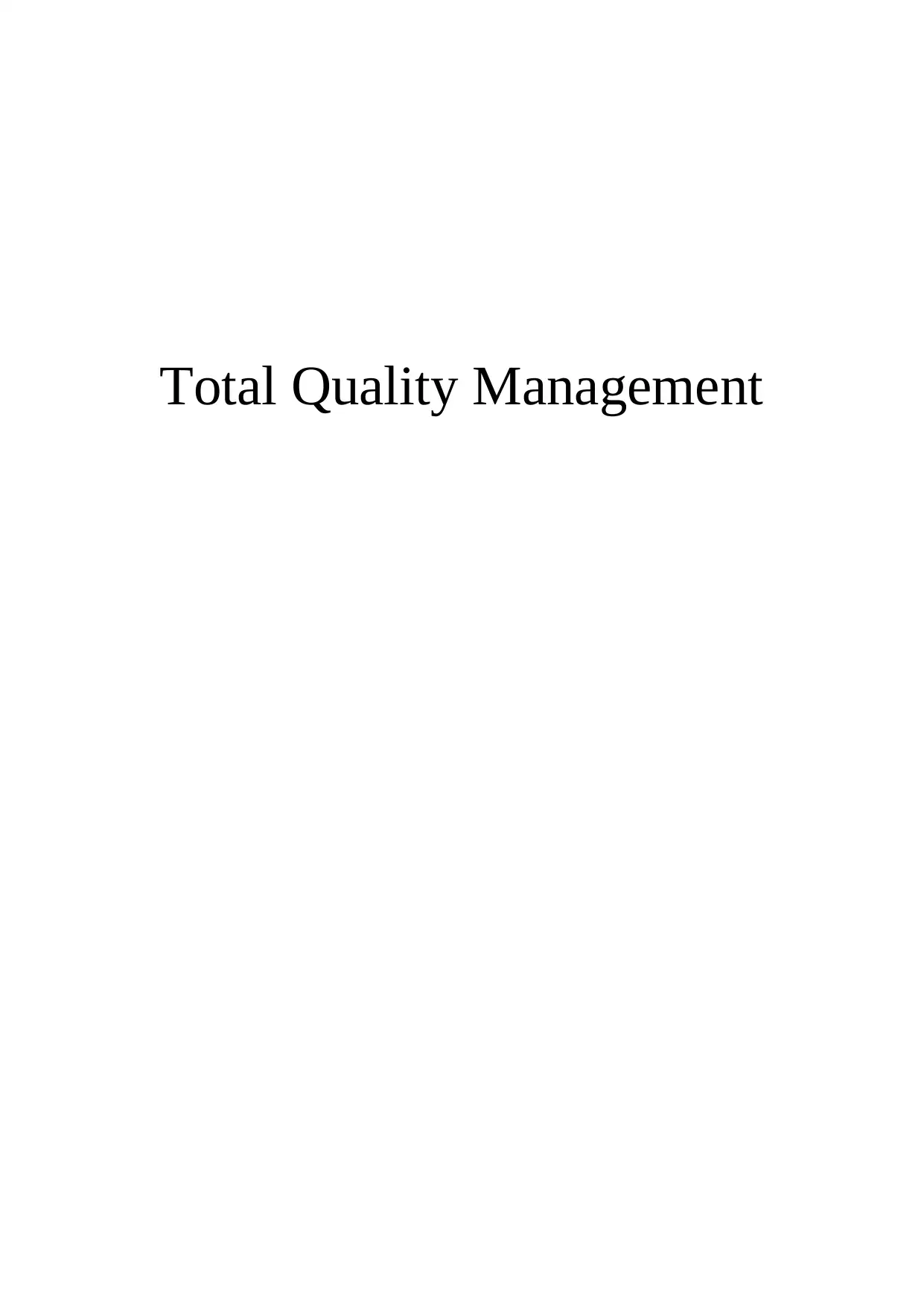
Total Quality Management
Secure Best Marks with AI Grader
Need help grading? Try our AI Grader for instant feedback on your assignments.
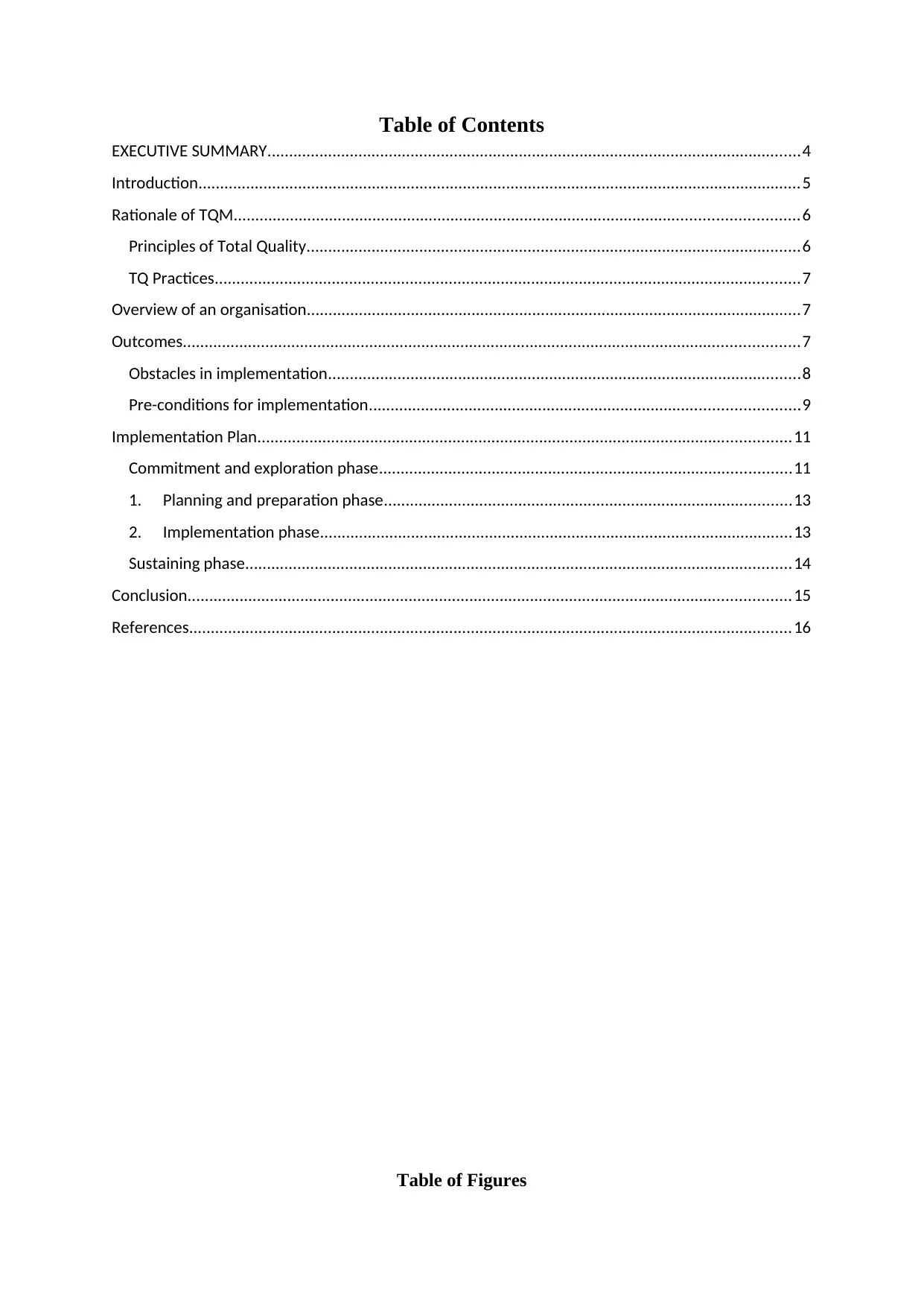
Table of Contents
EXECUTIVE SUMMARY...........................................................................................................................4
Introduction...........................................................................................................................................5
Rationale of TQM..................................................................................................................................6
Principles of Total Quality..................................................................................................................6
TQ Practices.......................................................................................................................................7
Overview of an organisation..................................................................................................................7
Outcomes..............................................................................................................................................7
Obstacles in implementation.............................................................................................................8
Pre-conditions for implementation...................................................................................................9
Implementation Plan...........................................................................................................................11
Commitment and exploration phase...............................................................................................11
1. Planning and preparation phase..............................................................................................13
2. Implementation phase.............................................................................................................13
Sustaining phase..............................................................................................................................14
Conclusion...........................................................................................................................................15
References...........................................................................................................................................16
Table of Figures
EXECUTIVE SUMMARY...........................................................................................................................4
Introduction...........................................................................................................................................5
Rationale of TQM..................................................................................................................................6
Principles of Total Quality..................................................................................................................6
TQ Practices.......................................................................................................................................7
Overview of an organisation..................................................................................................................7
Outcomes..............................................................................................................................................7
Obstacles in implementation.............................................................................................................8
Pre-conditions for implementation...................................................................................................9
Implementation Plan...........................................................................................................................11
Commitment and exploration phase...............................................................................................11
1. Planning and preparation phase..............................................................................................13
2. Implementation phase.............................................................................................................13
Sustaining phase..............................................................................................................................14
Conclusion...........................................................................................................................................15
References...........................................................................................................................................16
Table of Figures

Figure 1 Cultural audit process for TQM implementation.........................................................8
Figure 2 TQM road map(exploration and commitment phase)...............................................10
Figure 2 TQM road map(exploration and commitment phase)...............................................10
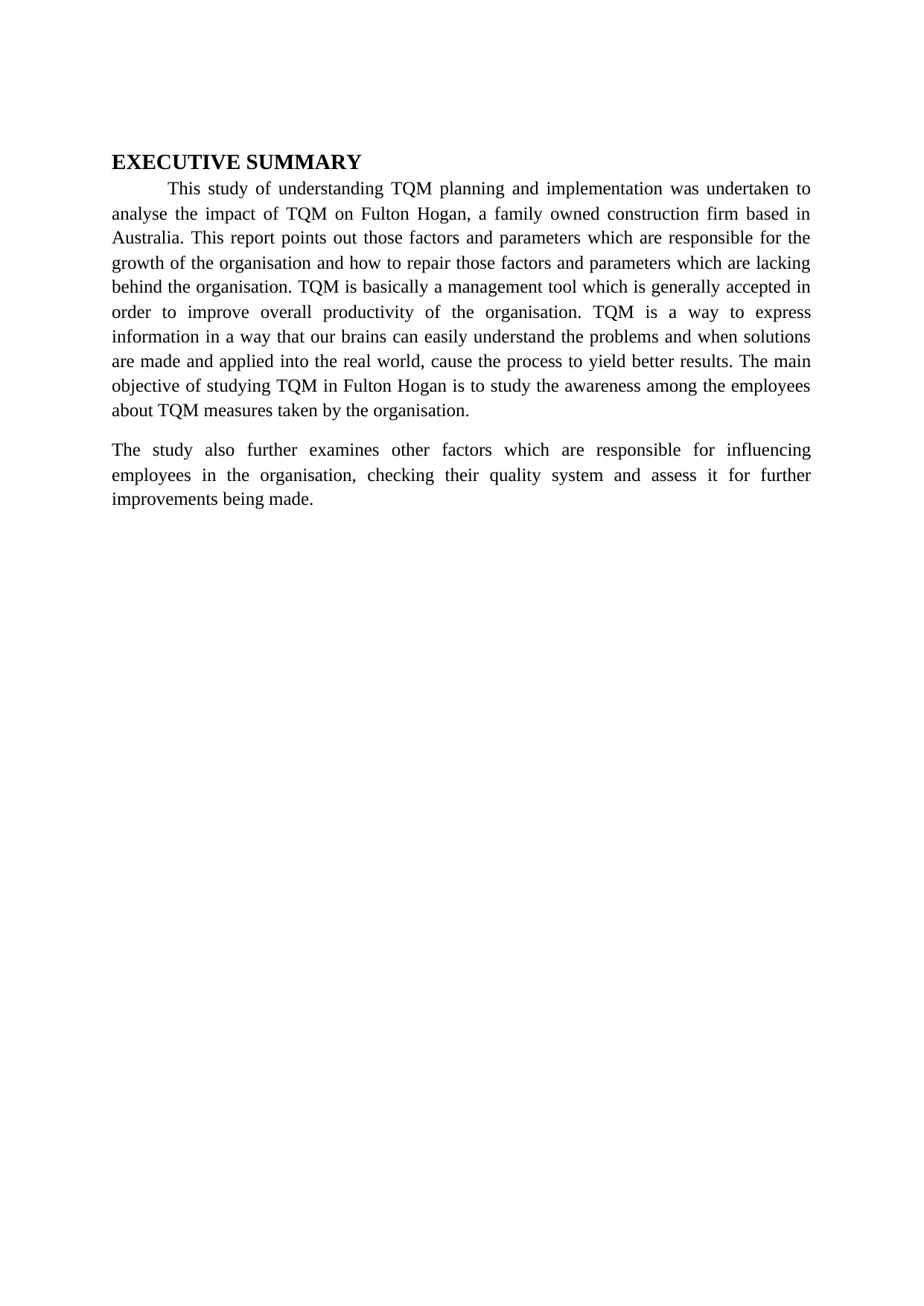
EXECUTIVE SUMMARY
This study of understanding TQM planning and implementation was undertaken to
analyse the impact of TQM on Fulton Hogan, a family owned construction firm based in
Australia. This report points out those factors and parameters which are responsible for the
growth of the organisation and how to repair those factors and parameters which are lacking
behind the organisation. TQM is basically a management tool which is generally accepted in
order to improve overall productivity of the organisation. TQM is a way to express
information in a way that our brains can easily understand the problems and when solutions
are made and applied into the real world, cause the process to yield better results. The main
objective of studying TQM in Fulton Hogan is to study the awareness among the employees
about TQM measures taken by the organisation.
The study also further examines other factors which are responsible for influencing
employees in the organisation, checking their quality system and assess it for further
improvements being made.
This study of understanding TQM planning and implementation was undertaken to
analyse the impact of TQM on Fulton Hogan, a family owned construction firm based in
Australia. This report points out those factors and parameters which are responsible for the
growth of the organisation and how to repair those factors and parameters which are lacking
behind the organisation. TQM is basically a management tool which is generally accepted in
order to improve overall productivity of the organisation. TQM is a way to express
information in a way that our brains can easily understand the problems and when solutions
are made and applied into the real world, cause the process to yield better results. The main
objective of studying TQM in Fulton Hogan is to study the awareness among the employees
about TQM measures taken by the organisation.
The study also further examines other factors which are responsible for influencing
employees in the organisation, checking their quality system and assess it for further
improvements being made.
Secure Best Marks with AI Grader
Need help grading? Try our AI Grader for instant feedback on your assignments.
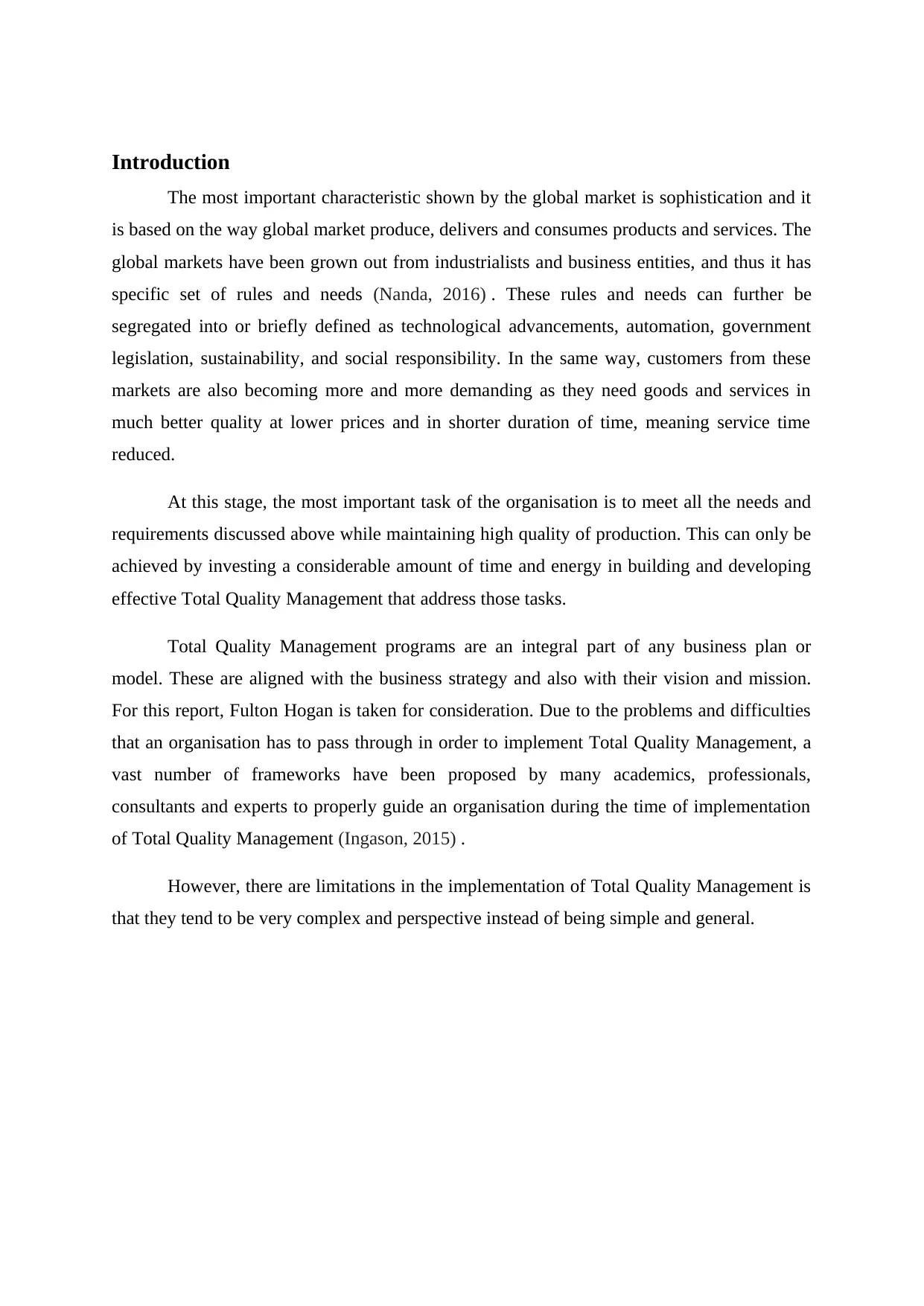
Introduction
The most important characteristic shown by the global market is sophistication and it
is based on the way global market produce, delivers and consumes products and services. The
global markets have been grown out from industrialists and business entities, and thus it has
specific set of rules and needs (Nanda, 2016) . These rules and needs can further be
segregated into or briefly defined as technological advancements, automation, government
legislation, sustainability, and social responsibility. In the same way, customers from these
markets are also becoming more and more demanding as they need goods and services in
much better quality at lower prices and in shorter duration of time, meaning service time
reduced.
At this stage, the most important task of the organisation is to meet all the needs and
requirements discussed above while maintaining high quality of production. This can only be
achieved by investing a considerable amount of time and energy in building and developing
effective Total Quality Management that address those tasks.
Total Quality Management programs are an integral part of any business plan or
model. These are aligned with the business strategy and also with their vision and mission.
For this report, Fulton Hogan is taken for consideration. Due to the problems and difficulties
that an organisation has to pass through in order to implement Total Quality Management, a
vast number of frameworks have been proposed by many academics, professionals,
consultants and experts to properly guide an organisation during the time of implementation
of Total Quality Management (Ingason, 2015) .
However, there are limitations in the implementation of Total Quality Management is
that they tend to be very complex and perspective instead of being simple and general.
The most important characteristic shown by the global market is sophistication and it
is based on the way global market produce, delivers and consumes products and services. The
global markets have been grown out from industrialists and business entities, and thus it has
specific set of rules and needs (Nanda, 2016) . These rules and needs can further be
segregated into or briefly defined as technological advancements, automation, government
legislation, sustainability, and social responsibility. In the same way, customers from these
markets are also becoming more and more demanding as they need goods and services in
much better quality at lower prices and in shorter duration of time, meaning service time
reduced.
At this stage, the most important task of the organisation is to meet all the needs and
requirements discussed above while maintaining high quality of production. This can only be
achieved by investing a considerable amount of time and energy in building and developing
effective Total Quality Management that address those tasks.
Total Quality Management programs are an integral part of any business plan or
model. These are aligned with the business strategy and also with their vision and mission.
For this report, Fulton Hogan is taken for consideration. Due to the problems and difficulties
that an organisation has to pass through in order to implement Total Quality Management, a
vast number of frameworks have been proposed by many academics, professionals,
consultants and experts to properly guide an organisation during the time of implementation
of Total Quality Management (Ingason, 2015) .
However, there are limitations in the implementation of Total Quality Management is
that they tend to be very complex and perspective instead of being simple and general.

Rationale of TQM
The need of TQM in any organisation is based on its performance and in the direction
it is moving forward into. Why any organisation needs a change, because of its expected
performance is not coming. TQM brings in the change an organisation is required in order to
compete in this competitive market. The need assessment is based on some basic principles,
techniques and practices. Total Quality Management has been characterises by its principles,
techniques and practices (Psomas and Antony, 2015) . Where, principles being the ideology
and philosophy of TQM, practices being the activities which are carried out during the
process of implementation phase and techniques are the various tools which have been used
to effectively implement TQM. When they all work in coordination managers and employees
of that organisation get benefited and guided very well through the passing phase of Total
Quality Management.
Principles of Total Quality
There are basically three principles:
Focus on consumers and shareholders – a consumer is the primary judge of quality of any
product or service. The perception of the consumer is based on many different things like the
over-all experience, ownership, interaction time and quality. To fulfil this situation a
company needs to extend its reach well beyond merely meeting requirements, reducing errors
and solving customer complain. The main focus of organisation is its customers and
stakeholders, with the proper implementation of TQM the stakeholders and employees get
motivated and their knowledge and skills can be used in the success of the organisation
(Zaharias and Pappas, 2016) . TQM demonstrate commitment and loyalty towards
organisation which provides opportunities for their development and growth.
Employee engagement and working in a team – employee engagement can be done
successfully in try by providing them power and authority to take useful decisions,
because when managers give employees the tools to make better decisions and the
opportunity of freedom, the employees will make sure the quality and standard of
products and services they are offering.
The need of TQM in any organisation is based on its performance and in the direction
it is moving forward into. Why any organisation needs a change, because of its expected
performance is not coming. TQM brings in the change an organisation is required in order to
compete in this competitive market. The need assessment is based on some basic principles,
techniques and practices. Total Quality Management has been characterises by its principles,
techniques and practices (Psomas and Antony, 2015) . Where, principles being the ideology
and philosophy of TQM, practices being the activities which are carried out during the
process of implementation phase and techniques are the various tools which have been used
to effectively implement TQM. When they all work in coordination managers and employees
of that organisation get benefited and guided very well through the passing phase of Total
Quality Management.
Principles of Total Quality
There are basically three principles:
Focus on consumers and shareholders – a consumer is the primary judge of quality of any
product or service. The perception of the consumer is based on many different things like the
over-all experience, ownership, interaction time and quality. To fulfil this situation a
company needs to extend its reach well beyond merely meeting requirements, reducing errors
and solving customer complain. The main focus of organisation is its customers and
stakeholders, with the proper implementation of TQM the stakeholders and employees get
motivated and their knowledge and skills can be used in the success of the organisation
(Zaharias and Pappas, 2016) . TQM demonstrate commitment and loyalty towards
organisation which provides opportunities for their development and growth.
Employee engagement and working in a team – employee engagement can be done
successfully in try by providing them power and authority to take useful decisions,
because when managers give employees the tools to make better decisions and the
opportunity of freedom, the employees will make sure the quality and standard of
products and services they are offering.

Continuous improvement and learning process – mostly it refers to both large & rapid
and small & gradual improvements. These improvements could be, attracting more
customers through new products and services, or it could be reducing cost and
reducing errors and waste, or it could be increasing the productivity by using
efficiently all the resources available or it could also improve responsive time of the
organisation internally and externally both.
TQ Practices
TQ practices are basically the physical ground level work or activities which are done
in order to implement successfully implement TQM in any organisation (Nasim, 2018).
Since, the organisation referred in this report is from construction industry, the literature
study conducted to find out the determinants of TQ practices for any construction industry.
This area of TQ practices is a combination of various practices including many things related
to, top management commitment, empowerment of employee, employee retention programs,
cost to quality, process of improvement, vision, mission and strategic objectives, training and
development, policies to control quality, and some more depending upon the nature of
industry (Kumar and Sharma, 2017) .
Overview of an organisation
The construction industry is very unique in its working, because they are single
location and single production products which are also single handled to a particular
customer. Unlike in other industries where products are manufactured at same location into
same environmental factors. But in construction industry, each project has a different site and
every different location has different environmental factors. The referred organisation, Fulton
Hogan is a successful and enduring infrastructure construction firm globally and has an origin
in Australia. It is a family owned business with great values like keeping it REAL (Grudzień
and Hamrol, 2016) ,
Respect
Energy and effort
Attitude
Leadership
and small & gradual improvements. These improvements could be, attracting more
customers through new products and services, or it could be reducing cost and
reducing errors and waste, or it could be increasing the productivity by using
efficiently all the resources available or it could also improve responsive time of the
organisation internally and externally both.
TQ Practices
TQ practices are basically the physical ground level work or activities which are done
in order to implement successfully implement TQM in any organisation (Nasim, 2018).
Since, the organisation referred in this report is from construction industry, the literature
study conducted to find out the determinants of TQ practices for any construction industry.
This area of TQ practices is a combination of various practices including many things related
to, top management commitment, empowerment of employee, employee retention programs,
cost to quality, process of improvement, vision, mission and strategic objectives, training and
development, policies to control quality, and some more depending upon the nature of
industry (Kumar and Sharma, 2017) .
Overview of an organisation
The construction industry is very unique in its working, because they are single
location and single production products which are also single handled to a particular
customer. Unlike in other industries where products are manufactured at same location into
same environmental factors. But in construction industry, each project has a different site and
every different location has different environmental factors. The referred organisation, Fulton
Hogan is a successful and enduring infrastructure construction firm globally and has an origin
in Australia. It is a family owned business with great values like keeping it REAL (Grudzień
and Hamrol, 2016) ,
Respect
Energy and effort
Attitude
Leadership
Paraphrase This Document
Need a fresh take? Get an instant paraphrase of this document with our AI Paraphraser
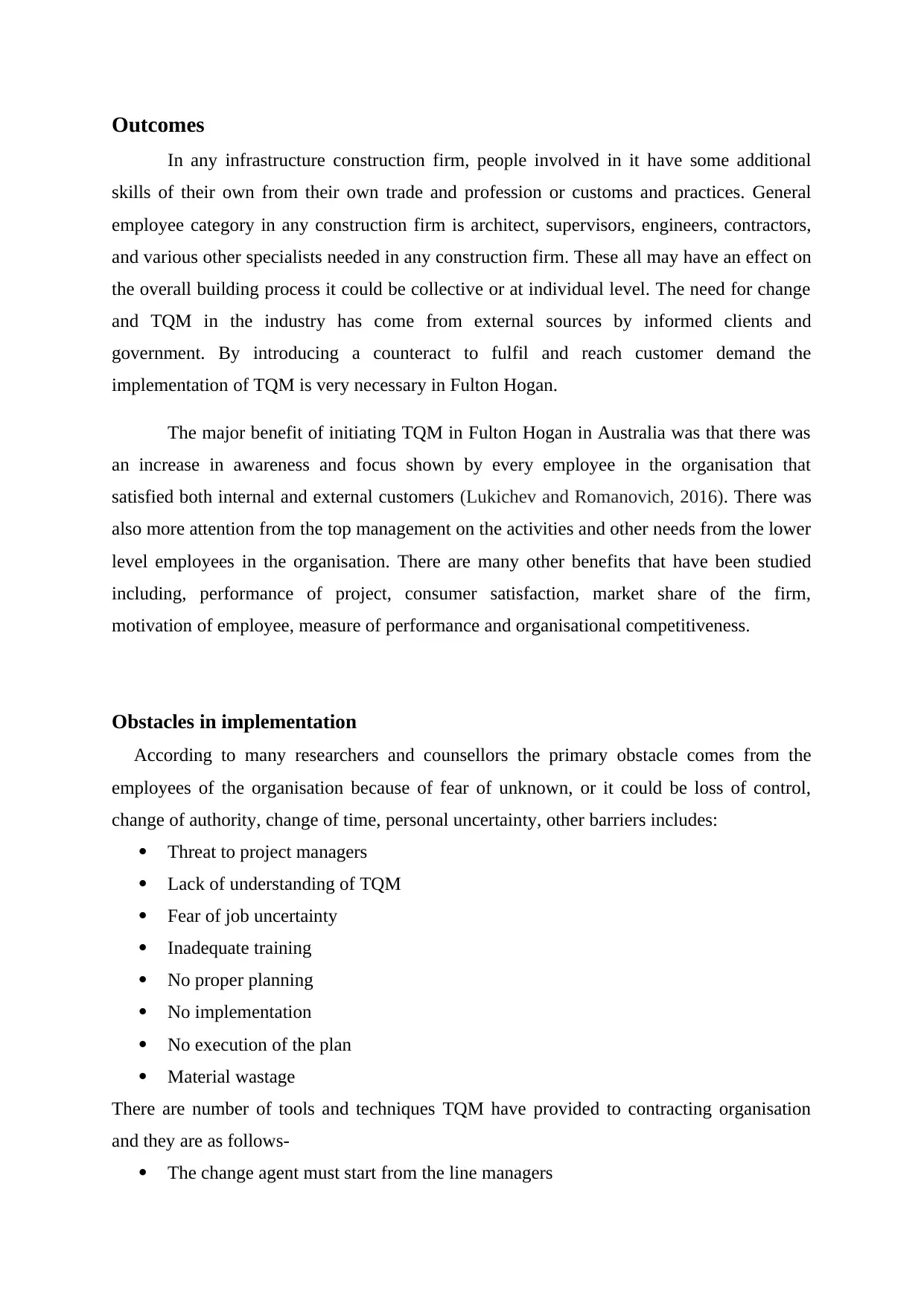
Outcomes
In any infrastructure construction firm, people involved in it have some additional
skills of their own from their own trade and profession or customs and practices. General
employee category in any construction firm is architect, supervisors, engineers, contractors,
and various other specialists needed in any construction firm. These all may have an effect on
the overall building process it could be collective or at individual level. The need for change
and TQM in the industry has come from external sources by informed clients and
government. By introducing a counteract to fulfil and reach customer demand the
implementation of TQM is very necessary in Fulton Hogan.
The major benefit of initiating TQM in Fulton Hogan in Australia was that there was
an increase in awareness and focus shown by every employee in the organisation that
satisfied both internal and external customers (Lukichev and Romanovich, 2016). There was
also more attention from the top management on the activities and other needs from the lower
level employees in the organisation. There are many other benefits that have been studied
including, performance of project, consumer satisfaction, market share of the firm,
motivation of employee, measure of performance and organisational competitiveness.
Obstacles in implementation
According to many researchers and counsellors the primary obstacle comes from the
employees of the organisation because of fear of unknown, or it could be loss of control,
change of authority, change of time, personal uncertainty, other barriers includes:
Threat to project managers
Lack of understanding of TQM
Fear of job uncertainty
Inadequate training
No proper planning
No implementation
No execution of the plan
Material wastage
There are number of tools and techniques TQM have provided to contracting organisation
and they are as follows-
The change agent must start from the line managers
In any infrastructure construction firm, people involved in it have some additional
skills of their own from their own trade and profession or customs and practices. General
employee category in any construction firm is architect, supervisors, engineers, contractors,
and various other specialists needed in any construction firm. These all may have an effect on
the overall building process it could be collective or at individual level. The need for change
and TQM in the industry has come from external sources by informed clients and
government. By introducing a counteract to fulfil and reach customer demand the
implementation of TQM is very necessary in Fulton Hogan.
The major benefit of initiating TQM in Fulton Hogan in Australia was that there was
an increase in awareness and focus shown by every employee in the organisation that
satisfied both internal and external customers (Lukichev and Romanovich, 2016). There was
also more attention from the top management on the activities and other needs from the lower
level employees in the organisation. There are many other benefits that have been studied
including, performance of project, consumer satisfaction, market share of the firm,
motivation of employee, measure of performance and organisational competitiveness.
Obstacles in implementation
According to many researchers and counsellors the primary obstacle comes from the
employees of the organisation because of fear of unknown, or it could be loss of control,
change of authority, change of time, personal uncertainty, other barriers includes:
Threat to project managers
Lack of understanding of TQM
Fear of job uncertainty
Inadequate training
No proper planning
No implementation
No execution of the plan
Material wastage
There are number of tools and techniques TQM have provided to contracting organisation
and they are as follows-
The change agent must start from the line managers
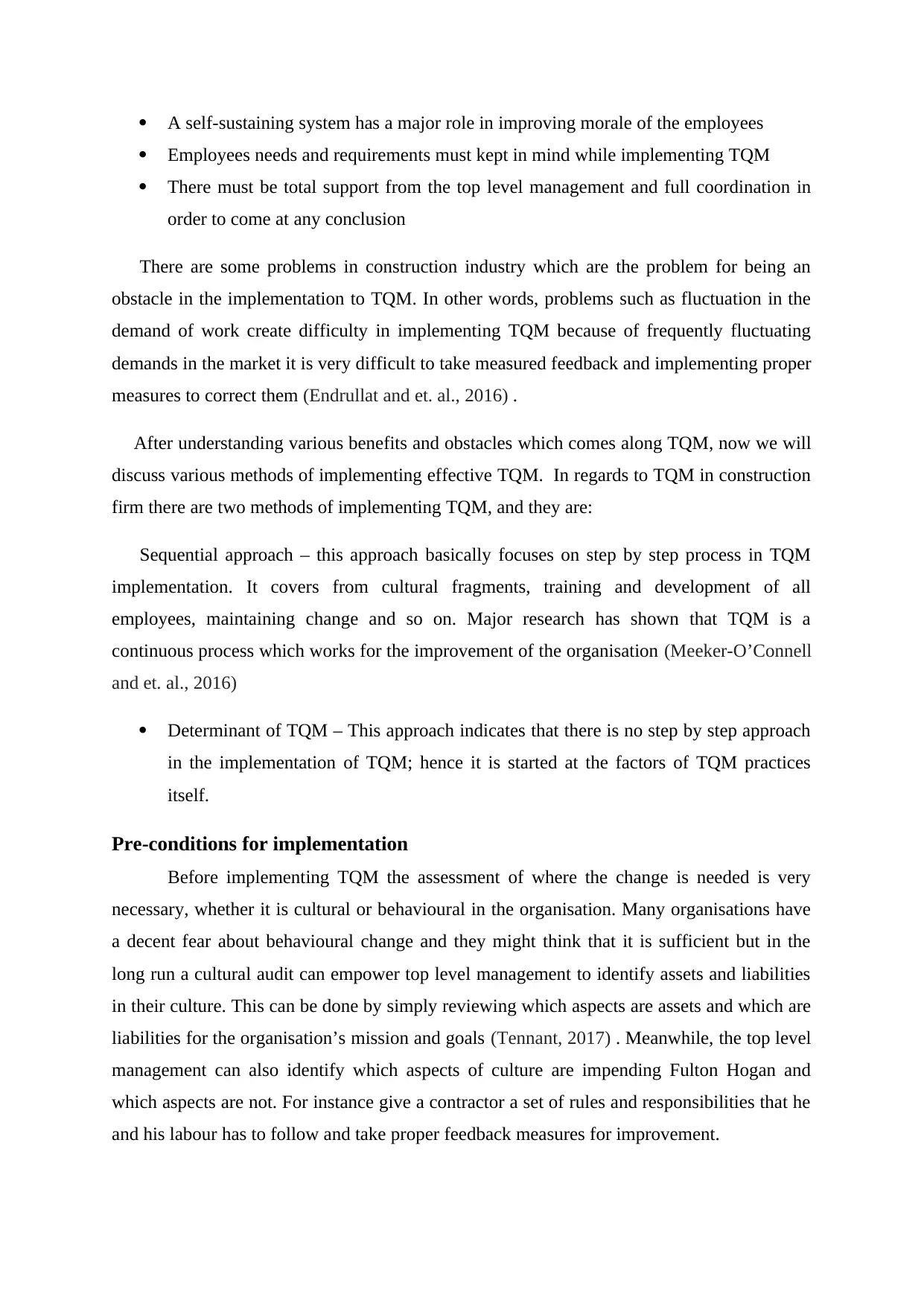
A self-sustaining system has a major role in improving morale of the employees
Employees needs and requirements must kept in mind while implementing TQM
There must be total support from the top level management and full coordination in
order to come at any conclusion
There are some problems in construction industry which are the problem for being an
obstacle in the implementation to TQM. In other words, problems such as fluctuation in the
demand of work create difficulty in implementing TQM because of frequently fluctuating
demands in the market it is very difficult to take measured feedback and implementing proper
measures to correct them (Endrullat and et. al., 2016) .
After understanding various benefits and obstacles which comes along TQM, now we will
discuss various methods of implementing effective TQM. In regards to TQM in construction
firm there are two methods of implementing TQM, and they are:
Sequential approach – this approach basically focuses on step by step process in TQM
implementation. It covers from cultural fragments, training and development of all
employees, maintaining change and so on. Major research has shown that TQM is a
continuous process which works for the improvement of the organisation (Meeker-O’Connell
and et. al., 2016)
Determinant of TQM – This approach indicates that there is no step by step approach
in the implementation of TQM; hence it is started at the factors of TQM practices
itself.
Pre-conditions for implementation
Before implementing TQM the assessment of where the change is needed is very
necessary, whether it is cultural or behavioural in the organisation. Many organisations have
a decent fear about behavioural change and they might think that it is sufficient but in the
long run a cultural audit can empower top level management to identify assets and liabilities
in their culture. This can be done by simply reviewing which aspects are assets and which are
liabilities for the organisation’s mission and goals (Tennant, 2017) . Meanwhile, the top level
management can also identify which aspects of culture are impending Fulton Hogan and
which aspects are not. For instance give a contractor a set of rules and responsibilities that he
and his labour has to follow and take proper feedback measures for improvement.
Employees needs and requirements must kept in mind while implementing TQM
There must be total support from the top level management and full coordination in
order to come at any conclusion
There are some problems in construction industry which are the problem for being an
obstacle in the implementation to TQM. In other words, problems such as fluctuation in the
demand of work create difficulty in implementing TQM because of frequently fluctuating
demands in the market it is very difficult to take measured feedback and implementing proper
measures to correct them (Endrullat and et. al., 2016) .
After understanding various benefits and obstacles which comes along TQM, now we will
discuss various methods of implementing effective TQM. In regards to TQM in construction
firm there are two methods of implementing TQM, and they are:
Sequential approach – this approach basically focuses on step by step process in TQM
implementation. It covers from cultural fragments, training and development of all
employees, maintaining change and so on. Major research has shown that TQM is a
continuous process which works for the improvement of the organisation (Meeker-O’Connell
and et. al., 2016)
Determinant of TQM – This approach indicates that there is no step by step approach
in the implementation of TQM; hence it is started at the factors of TQM practices
itself.
Pre-conditions for implementation
Before implementing TQM the assessment of where the change is needed is very
necessary, whether it is cultural or behavioural in the organisation. Many organisations have
a decent fear about behavioural change and they might think that it is sufficient but in the
long run a cultural audit can empower top level management to identify assets and liabilities
in their culture. This can be done by simply reviewing which aspects are assets and which are
liabilities for the organisation’s mission and goals (Tennant, 2017) . Meanwhile, the top level
management can also identify which aspects of culture are impending Fulton Hogan and
which aspects are not. For instance give a contractor a set of rules and responsibilities that he
and his labour has to follow and take proper feedback measures for improvement.
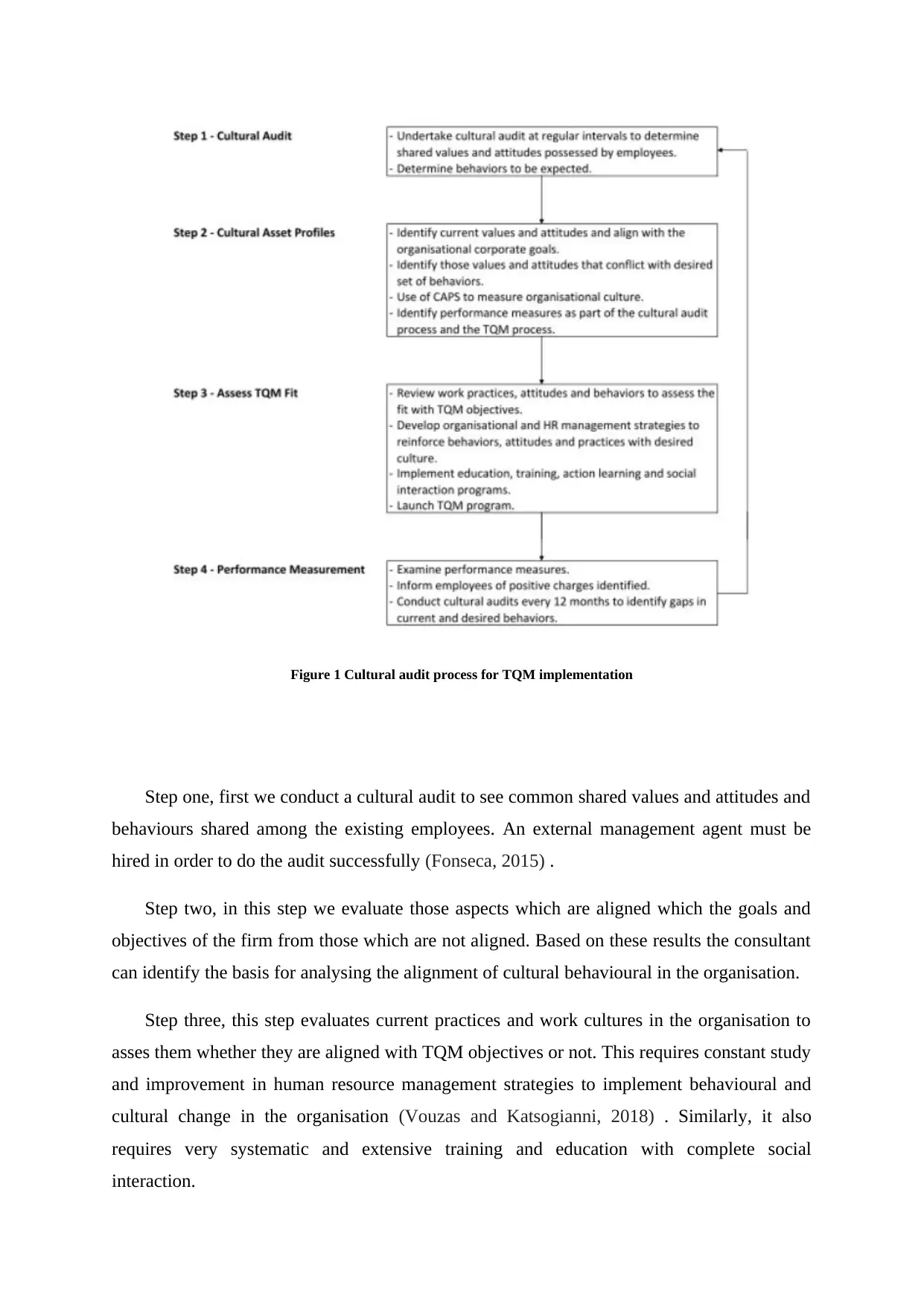
Figure 1 Cultural audit process for TQM implementation
Step one, first we conduct a cultural audit to see common shared values and attitudes and
behaviours shared among the existing employees. An external management agent must be
hired in order to do the audit successfully (Fonseca, 2015) .
Step two, in this step we evaluate those aspects which are aligned which the goals and
objectives of the firm from those which are not aligned. Based on these results the consultant
can identify the basis for analysing the alignment of cultural behavioural in the organisation.
Step three, this step evaluates current practices and work cultures in the organisation to
asses them whether they are aligned with TQM objectives or not. This requires constant study
and improvement in human resource management strategies to implement behavioural and
cultural change in the organisation (Vouzas and Katsogianni, 2018) . Similarly, it also
requires very systematic and extensive training and education with complete social
interaction.
Step one, first we conduct a cultural audit to see common shared values and attitudes and
behaviours shared among the existing employees. An external management agent must be
hired in order to do the audit successfully (Fonseca, 2015) .
Step two, in this step we evaluate those aspects which are aligned which the goals and
objectives of the firm from those which are not aligned. Based on these results the consultant
can identify the basis for analysing the alignment of cultural behavioural in the organisation.
Step three, this step evaluates current practices and work cultures in the organisation to
asses them whether they are aligned with TQM objectives or not. This requires constant study
and improvement in human resource management strategies to implement behavioural and
cultural change in the organisation (Vouzas and Katsogianni, 2018) . Similarly, it also
requires very systematic and extensive training and education with complete social
interaction.
Secure Best Marks with AI Grader
Need help grading? Try our AI Grader for instant feedback on your assignments.
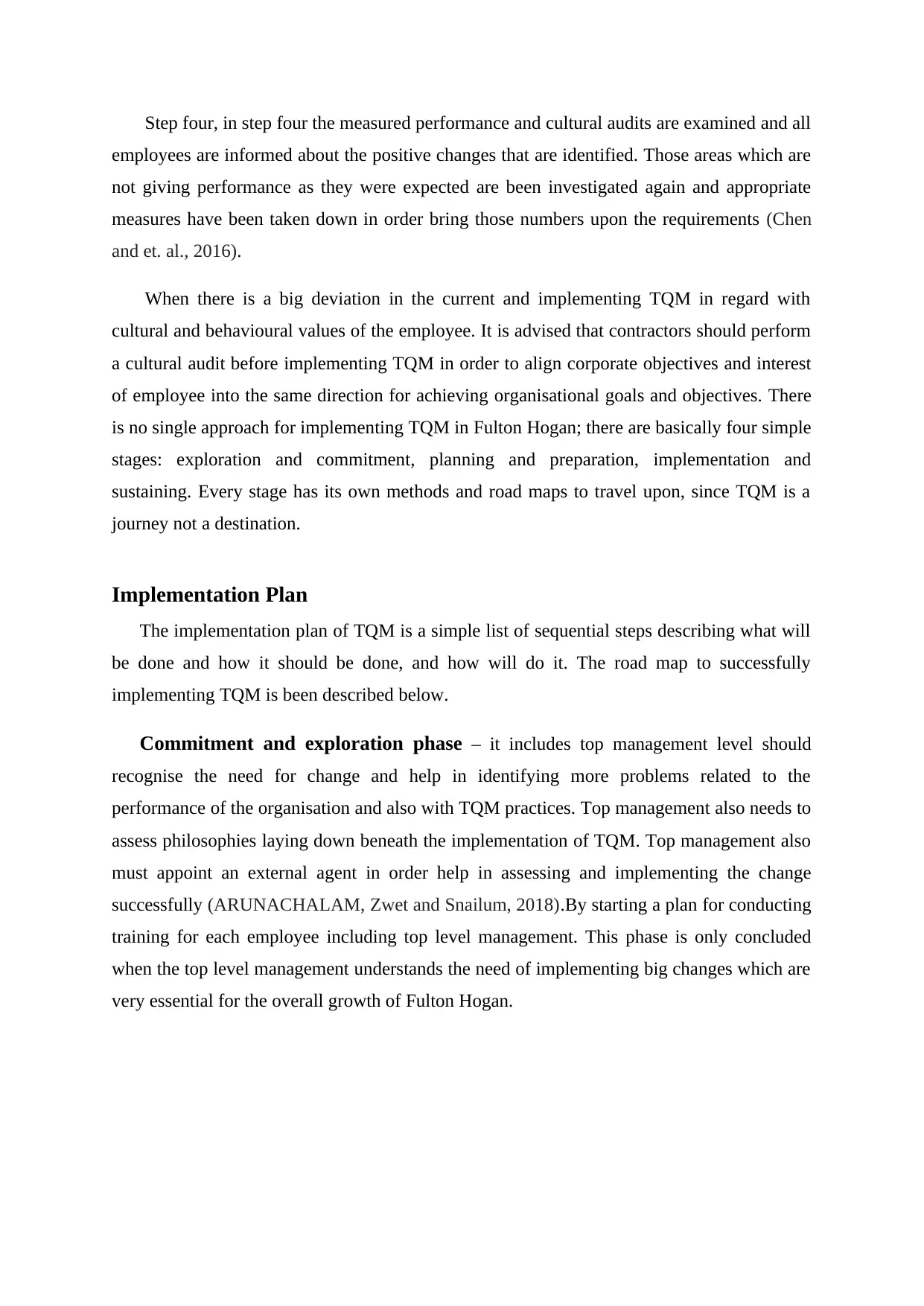
Step four, in step four the measured performance and cultural audits are examined and all
employees are informed about the positive changes that are identified. Those areas which are
not giving performance as they were expected are been investigated again and appropriate
measures have been taken down in order bring those numbers upon the requirements (Chen
and et. al., 2016).
When there is a big deviation in the current and implementing TQM in regard with
cultural and behavioural values of the employee. It is advised that contractors should perform
a cultural audit before implementing TQM in order to align corporate objectives and interest
of employee into the same direction for achieving organisational goals and objectives. There
is no single approach for implementing TQM in Fulton Hogan; there are basically four simple
stages: exploration and commitment, planning and preparation, implementation and
sustaining. Every stage has its own methods and road maps to travel upon, since TQM is a
journey not a destination.
Implementation Plan
The implementation plan of TQM is a simple list of sequential steps describing what will
be done and how it should be done, and how will do it. The road map to successfully
implementing TQM is been described below.
Commitment and exploration phase – it includes top management level should
recognise the need for change and help in identifying more problems related to the
performance of the organisation and also with TQM practices. Top management also needs to
assess philosophies laying down beneath the implementation of TQM. Top management also
must appoint an external agent in order help in assessing and implementing the change
successfully (ARUNACHALAM, Zwet and Snailum, 2018).By starting a plan for conducting
training for each employee including top level management. This phase is only concluded
when the top level management understands the need of implementing big changes which are
very essential for the overall growth of Fulton Hogan.
employees are informed about the positive changes that are identified. Those areas which are
not giving performance as they were expected are been investigated again and appropriate
measures have been taken down in order bring those numbers upon the requirements (Chen
and et. al., 2016).
When there is a big deviation in the current and implementing TQM in regard with
cultural and behavioural values of the employee. It is advised that contractors should perform
a cultural audit before implementing TQM in order to align corporate objectives and interest
of employee into the same direction for achieving organisational goals and objectives. There
is no single approach for implementing TQM in Fulton Hogan; there are basically four simple
stages: exploration and commitment, planning and preparation, implementation and
sustaining. Every stage has its own methods and road maps to travel upon, since TQM is a
journey not a destination.
Implementation Plan
The implementation plan of TQM is a simple list of sequential steps describing what will
be done and how it should be done, and how will do it. The road map to successfully
implementing TQM is been described below.
Commitment and exploration phase – it includes top management level should
recognise the need for change and help in identifying more problems related to the
performance of the organisation and also with TQM practices. Top management also needs to
assess philosophies laying down beneath the implementation of TQM. Top management also
must appoint an external agent in order help in assessing and implementing the change
successfully (ARUNACHALAM, Zwet and Snailum, 2018).By starting a plan for conducting
training for each employee including top level management. This phase is only concluded
when the top level management understands the need of implementing big changes which are
very essential for the overall growth of Fulton Hogan.
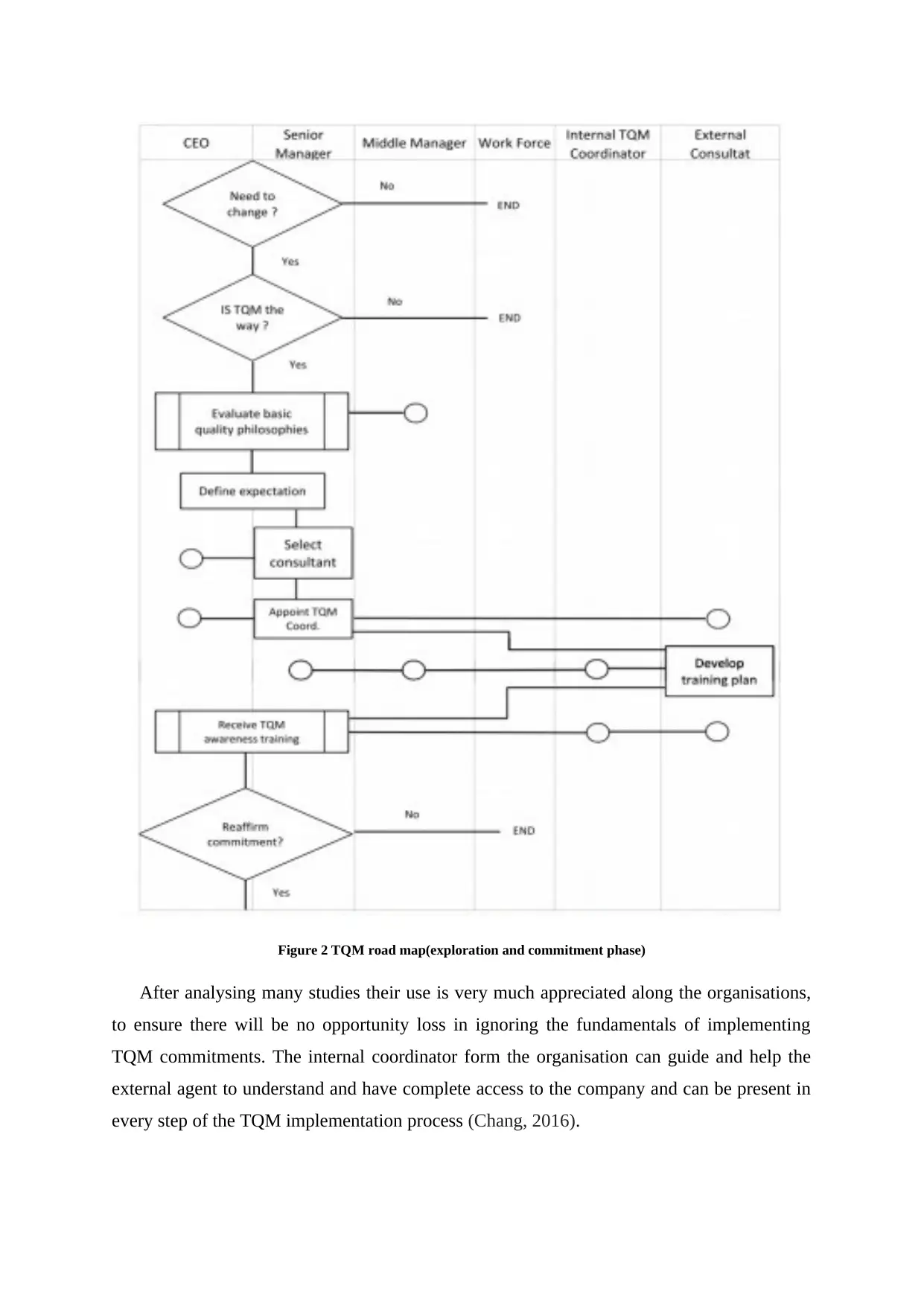
Figure 2 TQM road map(exploration and commitment phase)
After analysing many studies their use is very much appreciated along the organisations,
to ensure there will be no opportunity loss in ignoring the fundamentals of implementing
TQM commitments. The internal coordinator form the organisation can guide and help the
external agent to understand and have complete access to the company and can be present in
every step of the TQM implementation process (Chang, 2016).
After analysing many studies their use is very much appreciated along the organisations,
to ensure there will be no opportunity loss in ignoring the fundamentals of implementing
TQM commitments. The internal coordinator form the organisation can guide and help the
external agent to understand and have complete access to the company and can be present in
every step of the TQM implementation process (Chang, 2016).
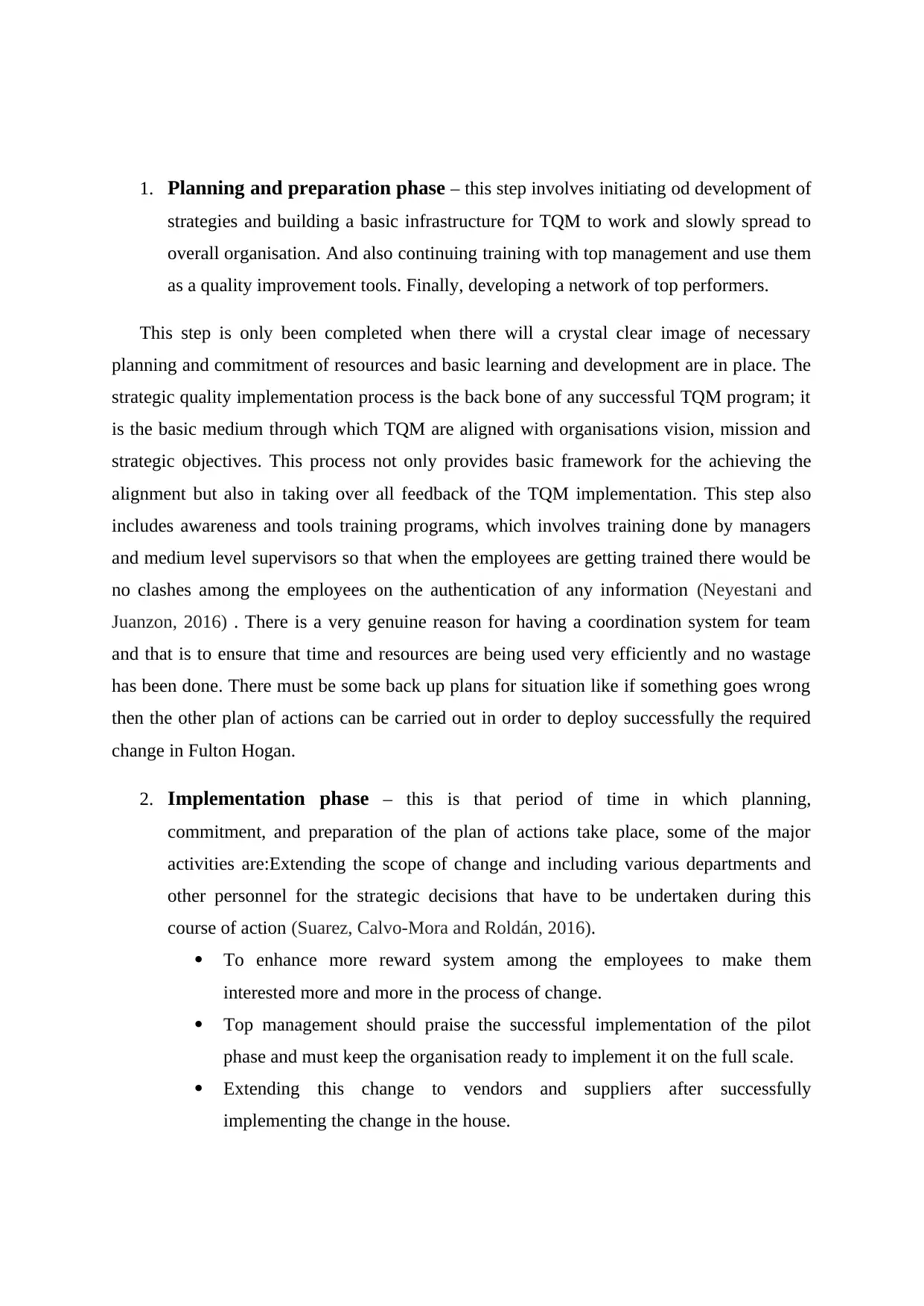
1. Planning and preparation phase – this step involves initiating od development of
strategies and building a basic infrastructure for TQM to work and slowly spread to
overall organisation. And also continuing training with top management and use them
as a quality improvement tools. Finally, developing a network of top performers.
This step is only been completed when there will a crystal clear image of necessary
planning and commitment of resources and basic learning and development are in place. The
strategic quality implementation process is the back bone of any successful TQM program; it
is the basic medium through which TQM are aligned with organisations vision, mission and
strategic objectives. This process not only provides basic framework for the achieving the
alignment but also in taking over all feedback of the TQM implementation. This step also
includes awareness and tools training programs, which involves training done by managers
and medium level supervisors so that when the employees are getting trained there would be
no clashes among the employees on the authentication of any information (Neyestani and
Juanzon, 2016) . There is a very genuine reason for having a coordination system for team
and that is to ensure that time and resources are being used very efficiently and no wastage
has been done. There must be some back up plans for situation like if something goes wrong
then the other plan of actions can be carried out in order to deploy successfully the required
change in Fulton Hogan.
2. Implementation phase – this is that period of time in which planning,
commitment, and preparation of the plan of actions take place, some of the major
activities are:Extending the scope of change and including various departments and
other personnel for the strategic decisions that have to be undertaken during this
course of action (Suarez, Calvo-Mora and Roldán, 2016).
To enhance more reward system among the employees to make them
interested more and more in the process of change.
Top management should praise the successful implementation of the pilot
phase and must keep the organisation ready to implement it on the full scale.
Extending this change to vendors and suppliers after successfully
implementing the change in the house.
strategies and building a basic infrastructure for TQM to work and slowly spread to
overall organisation. And also continuing training with top management and use them
as a quality improvement tools. Finally, developing a network of top performers.
This step is only been completed when there will a crystal clear image of necessary
planning and commitment of resources and basic learning and development are in place. The
strategic quality implementation process is the back bone of any successful TQM program; it
is the basic medium through which TQM are aligned with organisations vision, mission and
strategic objectives. This process not only provides basic framework for the achieving the
alignment but also in taking over all feedback of the TQM implementation. This step also
includes awareness and tools training programs, which involves training done by managers
and medium level supervisors so that when the employees are getting trained there would be
no clashes among the employees on the authentication of any information (Neyestani and
Juanzon, 2016) . There is a very genuine reason for having a coordination system for team
and that is to ensure that time and resources are being used very efficiently and no wastage
has been done. There must be some back up plans for situation like if something goes wrong
then the other plan of actions can be carried out in order to deploy successfully the required
change in Fulton Hogan.
2. Implementation phase – this is that period of time in which planning,
commitment, and preparation of the plan of actions take place, some of the major
activities are:Extending the scope of change and including various departments and
other personnel for the strategic decisions that have to be undertaken during this
course of action (Suarez, Calvo-Mora and Roldán, 2016).
To enhance more reward system among the employees to make them
interested more and more in the process of change.
Top management should praise the successful implementation of the pilot
phase and must keep the organisation ready to implement it on the full scale.
Extending this change to vendors and suppliers after successfully
implementing the change in the house.
Paraphrase This Document
Need a fresh take? Get an instant paraphrase of this document with our AI Paraphraser
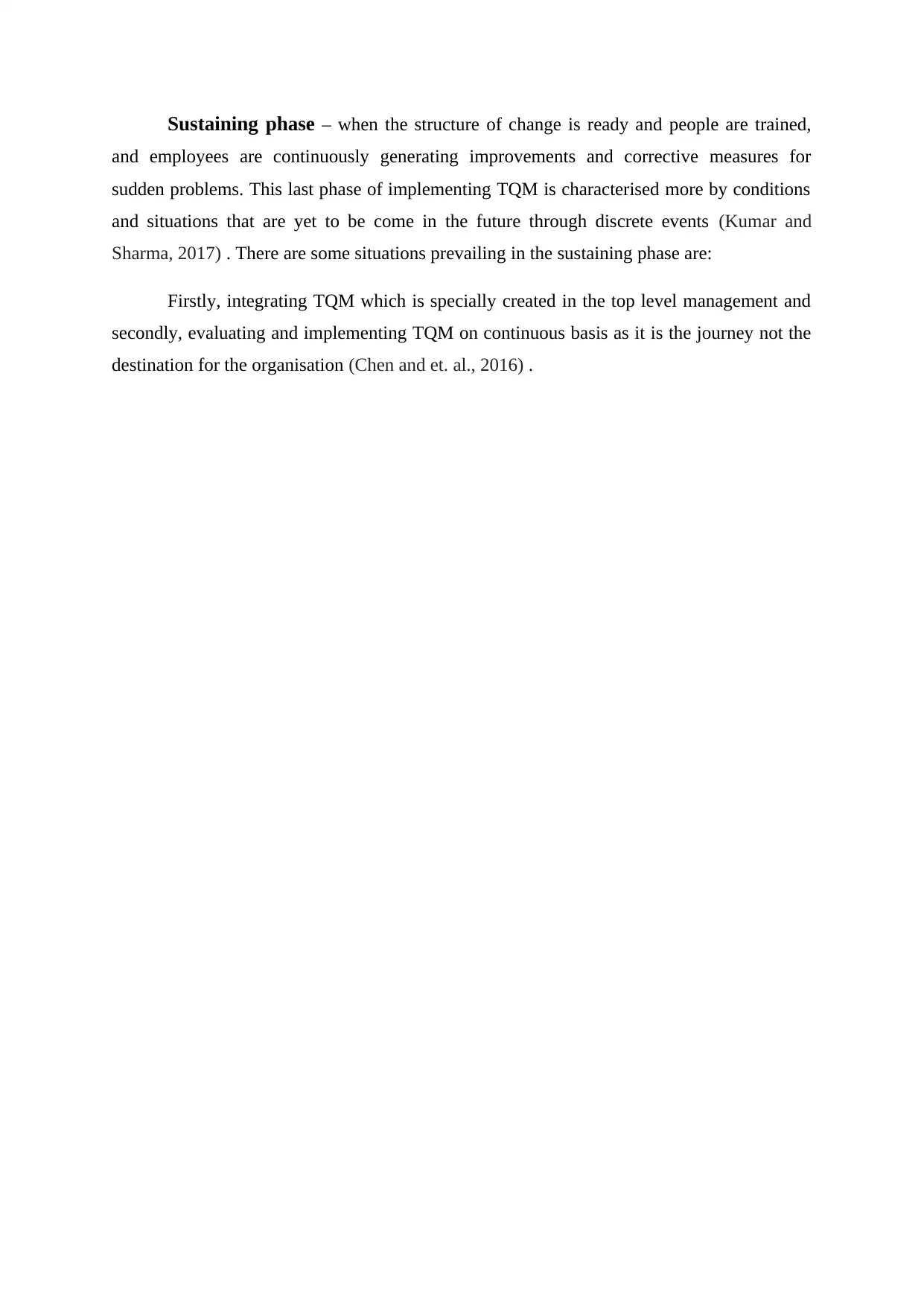
Sustaining phase – when the structure of change is ready and people are trained,
and employees are continuously generating improvements and corrective measures for
sudden problems. This last phase of implementing TQM is characterised more by conditions
and situations that are yet to be come in the future through discrete events (Kumar and
Sharma, 2017) . There are some situations prevailing in the sustaining phase are:
Firstly, integrating TQM which is specially created in the top level management and
secondly, evaluating and implementing TQM on continuous basis as it is the journey not the
destination for the organisation (Chen and et. al., 2016) .
and employees are continuously generating improvements and corrective measures for
sudden problems. This last phase of implementing TQM is characterised more by conditions
and situations that are yet to be come in the future through discrete events (Kumar and
Sharma, 2017) . There are some situations prevailing in the sustaining phase are:
Firstly, integrating TQM which is specially created in the top level management and
secondly, evaluating and implementing TQM on continuous basis as it is the journey not the
destination for the organisation (Chen and et. al., 2016) .

Conclusion
The conclusion of this report is by stating the fact that TQM does not have a universal
definition and which leaves out to the vast possibilities and more renovation and new ideas
into this field. As solutions are not directly applicable to every organisation and cases
therefore managers has to adapt and innovate new strategies to work according to the
situation or demand which initiated the requirement of change in the organisation.
Although there are step by step measures to assess and properly implement TQM in one shot
but these models and methods are just guidelines for TQM implementations. Having
understood that for every organisation the process of implementation of TQM will differ.
Considering the implementation of the TQM will bring some cultural changes and
differences, therefore it is very necessary to conduct a cultural audit before planning for TQM
implementation.
The conclusion of this report is by stating the fact that TQM does not have a universal
definition and which leaves out to the vast possibilities and more renovation and new ideas
into this field. As solutions are not directly applicable to every organisation and cases
therefore managers has to adapt and innovate new strategies to work according to the
situation or demand which initiated the requirement of change in the organisation.
Although there are step by step measures to assess and properly implement TQM in one shot
but these models and methods are just guidelines for TQM implementations. Having
understood that for every organisation the process of implementation of TQM will differ.
Considering the implementation of the TQM will bring some cultural changes and
differences, therefore it is very necessary to conduct a cultural audit before planning for TQM
implementation.
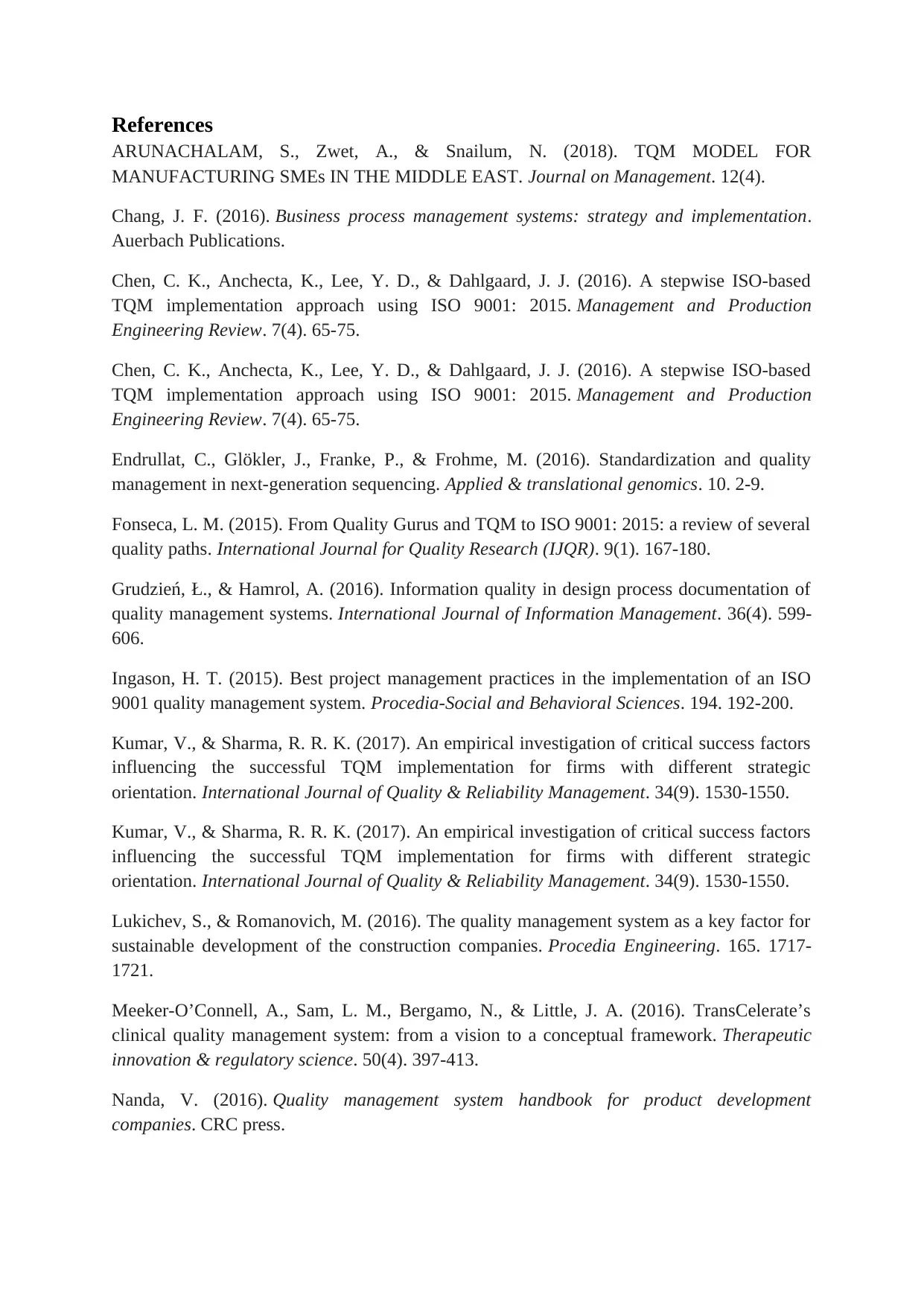
References
ARUNACHALAM, S., Zwet, A., & Snailum, N. (2018). TQM MODEL FOR
MANUFACTURING SMEs IN THE MIDDLE EAST. Journal on Management. 12(4).
Chang, J. F. (2016). Business process management systems: strategy and implementation.
Auerbach Publications.
Chen, C. K., Anchecta, K., Lee, Y. D., & Dahlgaard, J. J. (2016). A stepwise ISO-based
TQM implementation approach using ISO 9001: 2015. Management and Production
Engineering Review. 7(4). 65-75.
Chen, C. K., Anchecta, K., Lee, Y. D., & Dahlgaard, J. J. (2016). A stepwise ISO-based
TQM implementation approach using ISO 9001: 2015. Management and Production
Engineering Review. 7(4). 65-75.
Endrullat, C., Glökler, J., Franke, P., & Frohme, M. (2016). Standardization and quality
management in next-generation sequencing. Applied & translational genomics. 10. 2-9.
Fonseca, L. M. (2015). From Quality Gurus and TQM to ISO 9001: 2015: a review of several
quality paths. International Journal for Quality Research (IJQR). 9(1). 167-180.
Grudzień, Ł., & Hamrol, A. (2016). Information quality in design process documentation of
quality management systems. International Journal of Information Management. 36(4). 599-
606.
Ingason, H. T. (2015). Best project management practices in the implementation of an ISO
9001 quality management system. Procedia-Social and Behavioral Sciences. 194. 192-200.
Kumar, V., & Sharma, R. R. K. (2017). An empirical investigation of critical success factors
influencing the successful TQM implementation for firms with different strategic
orientation. International Journal of Quality & Reliability Management. 34(9). 1530-1550.
Kumar, V., & Sharma, R. R. K. (2017). An empirical investigation of critical success factors
influencing the successful TQM implementation for firms with different strategic
orientation. International Journal of Quality & Reliability Management. 34(9). 1530-1550.
Lukichev, S., & Romanovich, M. (2016). The quality management system as a key factor for
sustainable development of the construction companies. Procedia Engineering. 165. 1717-
1721.
Meeker-O’Connell, A., Sam, L. M., Bergamo, N., & Little, J. A. (2016). TransCelerate’s
clinical quality management system: from a vision to a conceptual framework. Therapeutic
innovation & regulatory science. 50(4). 397-413.
Nanda, V. (2016). Quality management system handbook for product development
companies. CRC press.
ARUNACHALAM, S., Zwet, A., & Snailum, N. (2018). TQM MODEL FOR
MANUFACTURING SMEs IN THE MIDDLE EAST. Journal on Management. 12(4).
Chang, J. F. (2016). Business process management systems: strategy and implementation.
Auerbach Publications.
Chen, C. K., Anchecta, K., Lee, Y. D., & Dahlgaard, J. J. (2016). A stepwise ISO-based
TQM implementation approach using ISO 9001: 2015. Management and Production
Engineering Review. 7(4). 65-75.
Chen, C. K., Anchecta, K., Lee, Y. D., & Dahlgaard, J. J. (2016). A stepwise ISO-based
TQM implementation approach using ISO 9001: 2015. Management and Production
Engineering Review. 7(4). 65-75.
Endrullat, C., Glökler, J., Franke, P., & Frohme, M. (2016). Standardization and quality
management in next-generation sequencing. Applied & translational genomics. 10. 2-9.
Fonseca, L. M. (2015). From Quality Gurus and TQM to ISO 9001: 2015: a review of several
quality paths. International Journal for Quality Research (IJQR). 9(1). 167-180.
Grudzień, Ł., & Hamrol, A. (2016). Information quality in design process documentation of
quality management systems. International Journal of Information Management. 36(4). 599-
606.
Ingason, H. T. (2015). Best project management practices in the implementation of an ISO
9001 quality management system. Procedia-Social and Behavioral Sciences. 194. 192-200.
Kumar, V., & Sharma, R. R. K. (2017). An empirical investigation of critical success factors
influencing the successful TQM implementation for firms with different strategic
orientation. International Journal of Quality & Reliability Management. 34(9). 1530-1550.
Kumar, V., & Sharma, R. R. K. (2017). An empirical investigation of critical success factors
influencing the successful TQM implementation for firms with different strategic
orientation. International Journal of Quality & Reliability Management. 34(9). 1530-1550.
Lukichev, S., & Romanovich, M. (2016). The quality management system as a key factor for
sustainable development of the construction companies. Procedia Engineering. 165. 1717-
1721.
Meeker-O’Connell, A., Sam, L. M., Bergamo, N., & Little, J. A. (2016). TransCelerate’s
clinical quality management system: from a vision to a conceptual framework. Therapeutic
innovation & regulatory science. 50(4). 397-413.
Nanda, V. (2016). Quality management system handbook for product development
companies. CRC press.
Secure Best Marks with AI Grader
Need help grading? Try our AI Grader for instant feedback on your assignments.
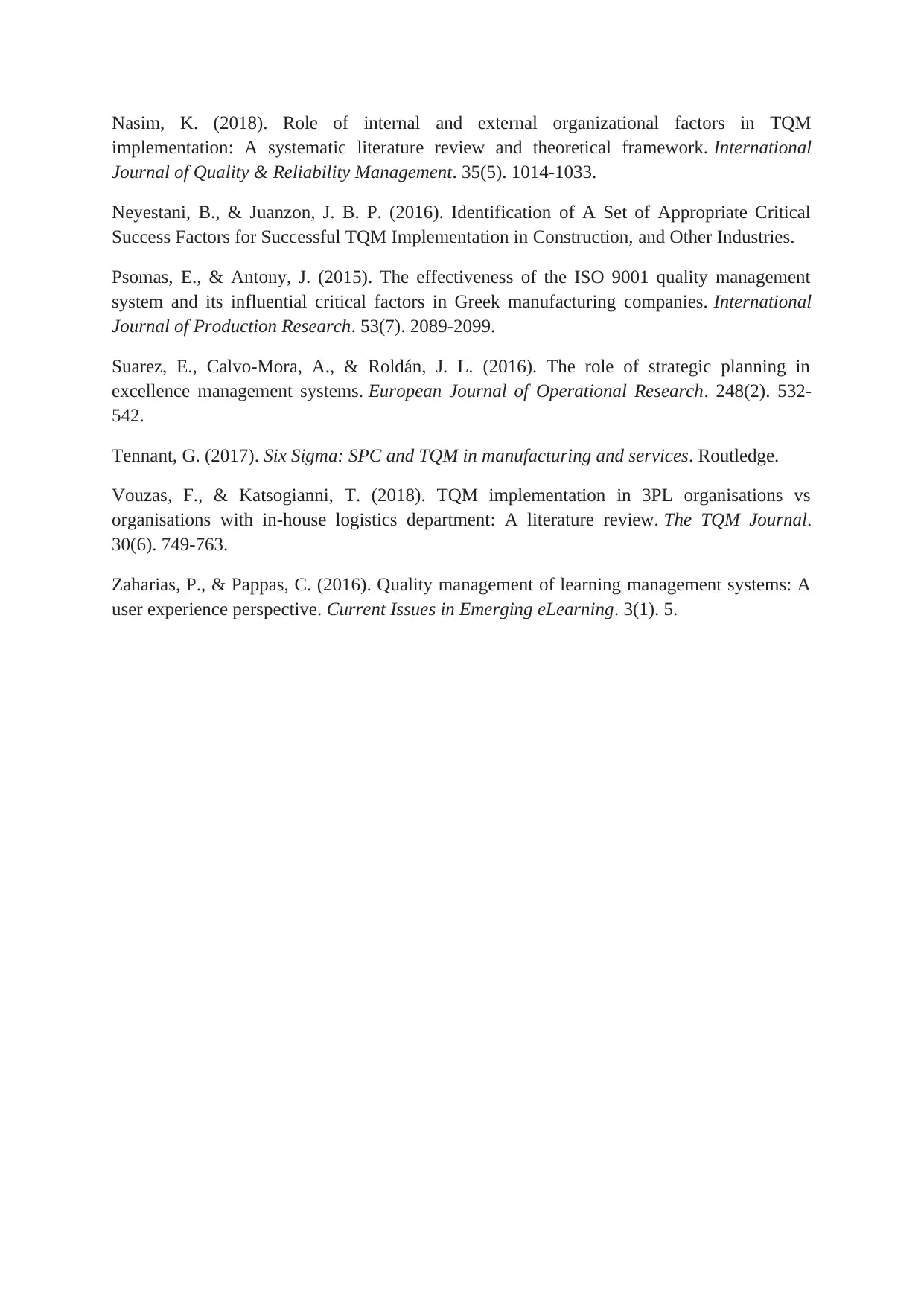
Nasim, K. (2018). Role of internal and external organizational factors in TQM
implementation: A systematic literature review and theoretical framework. International
Journal of Quality & Reliability Management. 35(5). 1014-1033.
Neyestani, B., & Juanzon, J. B. P. (2016). Identification of A Set of Appropriate Critical
Success Factors for Successful TQM Implementation in Construction, and Other Industries.
Psomas, E., & Antony, J. (2015). The effectiveness of the ISO 9001 quality management
system and its influential critical factors in Greek manufacturing companies. International
Journal of Production Research. 53(7). 2089-2099.
Suarez, E., Calvo-Mora, A., & Roldán, J. L. (2016). The role of strategic planning in
excellence management systems. European Journal of Operational Research. 248(2). 532-
542.
Tennant, G. (2017). Six Sigma: SPC and TQM in manufacturing and services. Routledge.
Vouzas, F., & Katsogianni, T. (2018). TQM implementation in 3PL organisations vs
organisations with in-house logistics department: A literature review. The TQM Journal.
30(6). 749-763.
Zaharias, P., & Pappas, C. (2016). Quality management of learning management systems: A
user experience perspective. Current Issues in Emerging eLearning. 3(1). 5.
implementation: A systematic literature review and theoretical framework. International
Journal of Quality & Reliability Management. 35(5). 1014-1033.
Neyestani, B., & Juanzon, J. B. P. (2016). Identification of A Set of Appropriate Critical
Success Factors for Successful TQM Implementation in Construction, and Other Industries.
Psomas, E., & Antony, J. (2015). The effectiveness of the ISO 9001 quality management
system and its influential critical factors in Greek manufacturing companies. International
Journal of Production Research. 53(7). 2089-2099.
Suarez, E., Calvo-Mora, A., & Roldán, J. L. (2016). The role of strategic planning in
excellence management systems. European Journal of Operational Research. 248(2). 532-
542.
Tennant, G. (2017). Six Sigma: SPC and TQM in manufacturing and services. Routledge.
Vouzas, F., & Katsogianni, T. (2018). TQM implementation in 3PL organisations vs
organisations with in-house logistics department: A literature review. The TQM Journal.
30(6). 749-763.
Zaharias, P., & Pappas, C. (2016). Quality management of learning management systems: A
user experience perspective. Current Issues in Emerging eLearning. 3(1). 5.
1 out of 17
Related Documents
Your All-in-One AI-Powered Toolkit for Academic Success.
+13062052269
info@desklib.com
Available 24*7 on WhatsApp / Email
![[object Object]](/_next/static/media/star-bottom.7253800d.svg)
Unlock your academic potential
© 2024 | Zucol Services PVT LTD | All rights reserved.





